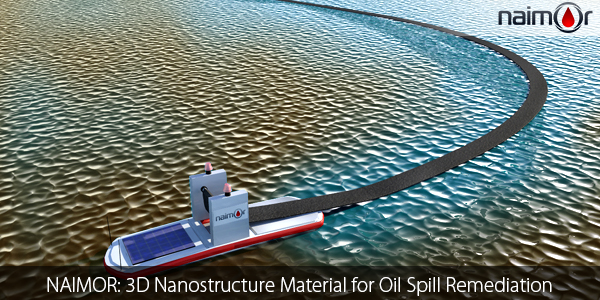
Photo Credit: NAIMOR
Oil spill disasters cost so much more than immediate recovery expenses. Loss of marine creatures and contamination of natural water resources often result in long term environmental costs and damages. Just one liter of oil can contaminate 1 million liters of drinking water.
Existing remedies for oil spills such as dispersants, controlled burning of surface oil, bioremediation, and natural degradation often require high costs while offering limited efficacy. This is why Ivano Aglietto, an Italian engineer with a PhD in Environmental Engineering developed RECAM® (REactive Carbon Material) for small and medium sized oil spills. RECAM is an ecofriendly and non toxic material which can absorb oil 90 times its own weight.
Recently, Aglietto and his team took a further step to develop a solution for large scale oil spills. The team launched an Indiegogo campaign to develop NAIMOR® – NAnostructure Innovative Material for Oil Recovery.
Like RECAM, NAIMOR is highly hydrophobic and can absorb oil around 150 times its own weight. The proposed material can be produced in various shapes and dimensions thanks to its three dimensional nanostructure carbon nature. According to the team’s campaign page, NAIMOR can be reused a number of times without losing its absorption capacity.
The material is regenerable and can be reused several times with no leftover wastes. The team proposed manufacturing different products with NAIMOR for the purpose of oil recovery which include:
Carpets – Floating carpets of NAIMOR® are distributed over the spill area and left there until they are completed saturated of oil. Once the oil is absorbed into the three dimensional nanostructure of NAIMOR, it can no longer be released into the water.
Dimension: 1x2x0.02m Weight: 400 g Oil Quantity Absorbed: 50 kg
Booms – These booms are moved on the surface of water with the help of boats on either side. Because of the double effects of confinement and absorption, the booms not only confine the oil distribution but also absorbs the oil more effectively. Once saturated with oil, the booms are recovered for oil removal.
Sheets – With the squeezing process, the oil is collected in a tank inside the drone boat, completely free of water and can be reused. After the regeneration process, the long NAIMOR® sheet is unrolled again and starts afresh to collect the oil.
Dimension: 1x200x0.02m Weight: 40 kg Oil Quantity Absorbed: 5 tons
– Source: NAIMOR
Once the products absorb oil, the team proposes a specialized squeezing process to recover the oil collected. Since NAIMOR is hydrophobic, the recovered oil is free of water and becomes a resource.
The campaign accepted contributions from $10 to $4500, with perks ranging from a Thank You email from NAIMOR inventor Ivano Aglietto to a contributor name or company logo sponsorship on the NAIMOR drone boats. As of February 2, the campaign raised nearly half of its $55,000 goal. The campaign stated it will use majority of the funds to produce the first prototype of the NAIMOR drone boat and pilot prototypes of NAIMOR carpets and sheets.





Leave a Comment